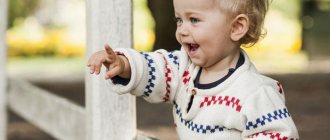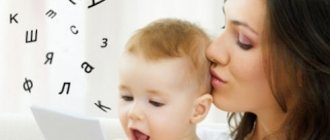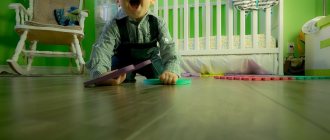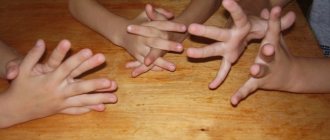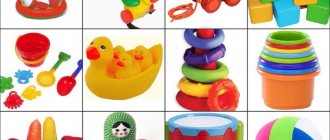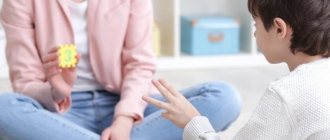One of the main challenges of raising children is that there are no strict requirements for what they should know when they reach a certain age. Therefore, parents are often interested in what exactly a child should be able to do at 2 years old, whether everything is okay with their baby, whether he corresponds to his age characteristics. It is important to understand that there are no uniform generally accepted standards - the level of development is largely determined by the individual abilities of the baby. However, it is customary to highlight a certain basis, that set of skills that a child must have.
Features of baby development
The age of 2 years is the time when children of different sexes begin to differ significantly from each other:
- boys weigh about 13-15 kg, their height is up to 92 cm;
- girls are lighter (up to 14 kg) and smaller (no higher than 90 cm).
Many children become active, love sports, enjoy running, playing with a ball, and swinging on swings.
Daily regime
At the age of two years, the child gets used to a constant routine. It is especially important to eat and sleep at the same time. The baby endures any failure quite hard, and then it is extremely difficult to get back into the usual rut. Therefore, parents should monitor these two main activities first. Other things: walks, games, etc. can be rescheduled if necessary. Sometimes swap walking outside with activities at home. The main thing is that the daily routine corresponds to the child’s biorhythms, helps him develop, grow healthy and happy.
| 7.00 – 7.30 | Waking up, hygiene procedures: washing, brushing teeth, combing, changing clothes; morning exercises (with parents, brothers and sisters) |
| 8.00 – 8.30 | Breakfast (milk porridge, vegetable stew, tea, juice with a bun or cookies) |
| 9.00 – 10.30 | Walk (in the off-season and winter you can go out later, and in the summer - before the heat sets in) |
| 10.30 – 12.00 | Home leisure, educational games, reading books, listening to music |
| 12.00 – 12.30 | Lunch (necessarily soup, vegetable or fruit puree, boiled meat or fish, compote. The baby has an excellent appetite at this time, so you need to feed him well, you can try a new dish) |
| 13.00 – 15.00 | Daytime nap (required, even if he is naughty and does not want to go to bed, you need to calm him down, read a short book, sing a lullaby) |
| 15.00 – 16.00 | Waking up, quiet games at home. Be sure to give him a drink, go to the potty, change clothes and wash himself |
| 16.00 – 16.30 | Afternoon snack (light meals: casserole, yogurt or cottage cheese, tea or juice, fruit) |
| 16.30 – 18.00 | Walk (in the fresh air, depending on the time of year, you can go sledding or in the summer go to a pond, run barefoot and jump) |
| 18.00 – 19.30 | Returning home, washing hands after a walk, dinner with family |
| 19.30 – 21.00 | Quiet games, communication, then air baths, massage, bathing and getting ready for bed |
| 21.00 – 7.00 | Dream |
The schedule is approximate, but nutrition and sleep should be clearly established. In the morning hours, you can keep your child busy with some kind of game. We need to gradually teach him to be independent. But at the same time, cook lunch nearby or do ironing. The baby must get used to the fact that he needs to be independent for some time, while adults do housework nearby.
Many children will enjoy playing with construction sets or drawing. It is not recommended to sit your baby in front of the TV. Even if your child is interested, still try to come up with a creative and calm activity. The psyche of a child at this age cannot withstand high volume, advertising, or constantly flashing pictures on the screen.
Age-related characteristics of the psyche and development of the cognitive sphere
At two years old, a child has striking features of thinking, attention and memory. Let's present them in table form.
| Characteristic | Features of children at 2 years old |
| Thinking | Abstract thinking develops. Imagination is formed (the child learns to think through a situation in his mind based on similar ones). He begins to understand the cause-and-effect relationships of events. He is good at relating a word to an object in reality. |
| Attention | Perceives those objects and phenomena that are in the zone of his vision. May have difficulty concentrating. |
| Memory | Gradually remembers the characteristics of objects (color, size). Remembers more words, the baby develops an active and passive vocabulary. |
At the age of two years, thinking develops visually and effectively, so it is necessary to give the child the opportunity to hold as many objects as possible - through contact with them he learns the world. At two years old, the baby needs communication with adults, so parents should talk with the baby as often as possible and answer his questions.
Development of cognitive skills and thinking
The development of a baby’s thinking directly depends on his speech. That is why you need to talk to your baby more often, discuss and comment on any actions, read books, and answer all questions without exception. The minimum cognitive skills of a two-year-old baby are:
- The ability to distinguish objects by characteristics: smooth - rough, warm - cold.
- The ability to assemble a multi-level pyramid of 6 parts without the help of adults.
- Ability to distinguish between 8 different color shades.
- Ability to group objects by characteristics.
- Knowledge of basic geometric shapes.
- Ability to perform simple dance or gymnastic movements.
- Ability to fold a matryoshka doll.
- Ability to assemble puzzles of 2-4 pieces.
A two-year-old child often seeks to imitate an adult and his actions. Don’t resist this enthusiasm, let the baby do “adult” things: let him learn to wipe dust, wash dishes, vacuum cleaner, hang laundry or load/take it out of the machine. A two-year-old child can know and be able to do much more than we can imagine. The main thing is to help him understand the world and encourage attempts at independence.
Let us repeat once again that all of the above is a conditional set of skills and abilities of a two-year-old child. But it is mandatory, so it is necessary to work with your baby. If you notice that the baby reacts poorly to an adult’s speech, makes no attempts to speak at all, ignores parents’ requests and does not respond to them in any way, does not communicate or play with peers - this is a reason for concern and an unscheduled visit to a specialist. The reasons may be:
- inflammation of the middle and inner zones of the ear;
- autism;
- delayed speech development;
- baby's ailments and other medical problems.
But making a diagnosis yourself is the last thing. In this case, a visit to a specialist is mandatory and is not subject to discussion. Only a doctor can make the correct diagnosis and prescribe the optimal solution to the problem.
Comments ()
Features of physical development
Children at the age of 2 years old do not know fear; they are able to climb to heights, but are not yet able to objectively assess the distance and, trying to get down, can receive serious injuries. That is why it is important for parents to know what to expect from their baby and to monitor him closely.
By the age of two, the baby should already have mastered a number of simple movements:
- go up and down stairs;
- change from walking to running;
- do not lose your balance when trying to jump on the spot or walk along a board or sidewalk curb;
- wander along an inclined plane;
- climb onto a chair or sofa;
- step over or jump over low obstacles;
- catch the ball thrown by the parent, hold it in your hands. While the distance for throwing should be small, the adult should move away from the baby by half a step, no more.
Children who have reached the age of two dance with pleasure to fiery music, are able to leaf through the pages of a book (several pages at a time), looking at pictures. Children also begin to develop their first drawing skills: they draw lines on paper (both horizontal and vertical), are able to depict curved “circles”.
Normal tantrums: how to deal with them?
On average, once a week you can expect a child of this age to be upset to the point of tears. Hysterics occurring up to 2-3 times a week can be considered the norm - much depends on the temperament and intensity of the child’s development. But if hysterics and tears are repeated up to 2-3 times a day, then the baby is either going through a critical period of development or is experiencing prolonged stress. If neither one nor the other is true, then you should contact a specialist: a neurologist, or a psychologist, or a homeopath.
Only future phlegmatic people manage without irritation and hysterics at the age of 2-3 years. That is, parents should prepare themselves for encounters with episodes of hysterics and learn to react to them correctly and behave correctly.
One of the main parenting skills that is acquired at this time is restraining the child’s emotional resistance, irritation and anger . What it is?
Here is a fairly typical example: a child does not want cartoons to be turned off. Or he doesn’t want to leave the sandbox and yells about it. A situation that few parents have not encountered. What might emotional containment look like?
Firstly, it is important not to connect to the child’s emotions - not to start speaking in a raised voice, screaming and getting angry.
Secondly, it is worth explaining to the child in a calm voice in an understandable language what is happening to him: “Vanya, you are very upset, you are angry, you don’t want to... leave the walk. Many children who are 2 years old really don’t want to go home when it’s time for lunch. But...” And then you list your own arguments why you should definitely go home.
This measure does not give immediate results; on the contrary, screaming and crying in the first minutes after such an explanation can only intensify.
But the long-term, cumulative effect is very good: over time, when 2-6 weeks have passed from the start of using this method of interpreting behavior , you will notice that the child begins to read not only his own behavior, but sometimes yours as well: “Mom is tired, mom wants to lie down " Over time, the child's ability to better understand his own condition, as well as the feelings and desires of other people, will only develop.
Why is this necessary? Despite the fact that our baby is already a speaking creature, the motives and reasons for his own behavior are most often incomprehensible to him. Even when the word “I” is already actively used, it is very difficult for the baby to understand and name the reason for his own joy or frustration. The child’s own complex desires and reluctances also cannot yet be clearly formulated. And here mom can help a lot, as a “children’s translator.”
Interpreting a child’s behavior is a universal way of responding to tantrums and other disruptions in his behavior.
Speech development
The vocabulary of many children at the age of two already contains more than a hundred words; children are happy to repeat simple poetic lines after their parents. However, it is also possible that the child has the skills to pronounce only a couple of words (for example, mom and dad). Both options are the norm, since the formation and development of speech skills is influenced by many factors.
- Children who communicate with peers, go to kindergarten, begin to talk earlier.
- Girls turn out to be more talkative than boys.
Therefore, parents should not be upset if their baby still speaks worse than the neighbor’s.
How many words is normal for a two-year-old child? It is impossible to give a definite answer, it all depends on the individual characteristics of the baby, but for many this figure tends to be 200-300. Two-year-olds are characterized by speech that is understandable to parents (although not always clear), and there may be a violation in the pronunciation of individual sounds and syllables.
Advice
You should speak to a child correctly, clearly, without distorting words and phrases in his own manner; this is the only way he will see before him an example of competent speech.
Love of tradition and the importance of routine
The child’s nervous system still retains features of rigidity and a tendency to inertia. This is not as pronounced as between one and two years, especially when the baby begins to speak freely, but it is quite noticeable. Young children are big conservatives and do not like innovations in food, clothing, arrangement of toys and the sequence of events during the day. It is difficult for a child of this age to offer not only a new, unfamiliar dish, but also familiar food in unfamiliar dishes.
And during weekends and vacations, when the usual routine is disrupted, children can behave much worse. This happens because the baby is highly dependent on the degree of fatigue and the number of impressions. This is another feature of the age of 2-3.5 years. If a child is knocked out of his usual routine for one reason or another, and there are too many impressions, he will behave worse than usual.
And nothing can be done here. You can influence the behavior of a child of this age only when he is calm, not too tired, well-fed and not out of his usual rhythm - in the so-called “green” range. But if at least one of the conditions described above is violated, any attempt to influence the child will lead to difficult behavior or hysteria.
What should a baby be able to do?
At this age, the child should already have developed some skills:
- the desire to repeat words after adults, without even understanding their meaning;
- gradually replace onomatopoeia with words;
- be able to say goodbye and hello, understand when it is appropriate;
- pronounce the names of animals and objects;
- You can often hear a child ask “what is this?”;
- a two-year-old child should already be able to pronounce his name, but can talk about himself in the third person;
- kids make sentences of more than three words and can verbally pronounce small texts of 3-5 sentences, expressing their thoughts. Most often, the baby talks about his desires and needs and uses simple words: “mom has come,” “let me lalya.”
The development of a child at 2 years old is characterized by the ability to distinguish words with opposite meanings: small and large, quickly and long. Most children are able to name familiar objects and give a brief description of them (green flower, yellow sun). Talking becomes a natural need for the baby.
Games for intellectual development
This group includes games aimed at improving fine motor skills and sensory perception. The way a child moves his fingers and arms is interconnected with the development of important brain centers, such as the centers of speech, vision, motor coordination, and thinking. What educational activities can you organize at home?
- Coloring large pictures and drawing with paints, crayons, pencils.
- Cutting out basic shapes from cardboard with scissors.
- Modeling from salt dough, plasticine, clay. Start with koloboks and sausages and gradually move on to more complex figures.
- Various applications made from paper, magazine pictures, cardboard.
- Games with small objects: beans, colored rice (color regular cereal with food coloring for eggs), buttons, shells, mini cars.
Let your child take apart a regular dresser drawer, just make sure all the items are safe first. Another simple game is to put beans or buttons into a plastic bottle with a narrow neck.
Don't ask your child to create a masterpiece right away. Always go from the simplest to the most complex and don’t put pressure on the child if he doesn’t succeed or is tired. Be sure to explain safety rules. Help him in the first lessons, over time he will learn to perform these actions on his own. Don't be stingy with praise, even if the house you painted doesn't look like a building. Set up a home exhibition and show your creations to other family members so that your child remembers the state of success.
Fine motor skills
Two years is the most suitable age for the development of fine motor skills, which are directly related to speech. Parents are required to regularly engage with their child using a variety of games.
It is best to start with the simplest options, gradually complicating the tasks.
- Rotation. The development of such a movement is very important for the baby, so you can invite him to twirl the spinning top or pin. You can use a table as a work surface, the floor is a place where the child is more comfortable, and completing the task does not cause difficulties.
- Working with a pencil and small hair ties. One of the adults picks up a simple pencil, the baby’s task is to put rubber bands on it. The exercise develops fine motor skills very well.
- Pencil and rope. To complete this you will need a regular pencil and tape, rope. The parent holds the pencil, the baby must wrap it with tape.
Such exercises are interesting for children, and most often they are performed with pleasure. It is important for parents to do this regularly, since the development of fine motor skills is the most important stage in preparing a child for school.
Already at 2 years old, it becomes clear whether the child will be right-handed or left-handed, since he begins to use his working hand most often, rarely using both at the same time. But it will be possible to accurately determine this only during school years.
Working with small objects
The next stage in the development of children’s motor skills at the age of two years is activities with small objects. These can be beads, beans, small-diameter pebbles.
You can give your child the following tasks:
- arrange the beads into different boxes;
- string them on a rope;
- place the stones on the table.
Modeling is very useful for the development of fine motor skills, so at least once a week you should introduce your child to plasticine. Children will also like this fun: an adult sculpts an oval out of plasticine (this is the body of a hedgehog), the child’s task is to decorate it with “needles”, the role of which will be played by matches or seeds. By sticking them into a soft surface, the baby will develop his skills.
Advice
It is important to teach your child to handle small objects only under the supervision of an adult; this will help prevent accidents.
Attention training
The ability to notice little things and concentrate on a specific task are skills that develop children by leaps and bounds. Successful mastery of them will help children in further education.
Include the following activities in your daily activity:
- Search. This game does not need additional attributes, so it is interesting always and everywhere. It allows you to develop the attention of a child from 1 year. Ask your treasure to find a white toy in the basket, point out a squirrel in a picture, or hand him his favorite plastic cup.
- Selection of items. Place various objects on the table and ask your child to choose objects of a certain color or with the same pattern. For example, let your child give you yellow clothespins. If you constantly play with a child aged 1-3 years, the baby will complete the task faster each time.
- Construction of a tower or house. Help your child build a castle from a pile of large parts. Before purchasing “building materials,” be sure to look at the manufacturer’s recommendations. Not all games can be played with a child from 1 to 3 years old.
- Search for objects with the same characteristic. Ask your little one to show her white toys or choose round objects from those laid out on the table. In general, a wise parent can come up with 1000 and 1 variants of educational games related to the search for some objects. You can link two properties of an item into one chain. For example, soft and white.
Basic Skills
A child who is already two years old should know the following:
- some geometric shapes (circle, triangle, square);
- eight colors (red, white, black, blue, yellow, green, brown, purple);
- objects according to their parameters (large and small, cold and hot, dry and wet).
At this age, imitation plays an important role, so the child often copies the actions of an adult, his movements, and dances.
By the age of two, a child should be able to assemble large puzzles from 3-4 components, a pyramid of 6 rings based on their size and color, fold a matryoshka doll - guess what it should look like, combine halves of the same size.
Advice
Parents should take advantage of their child's desire to imitate, entrusting him with the simplest household chores. Let him wipe the dust and put down a toy - this will help develop motor skills.
Motor skills.
A properly selected developmental environment is very important for a baby. What toys should I buy so that they don’t turn out to be superfluous and unnecessary? How to choose in the store exactly what your baby needs according to her age? Read all this in the article: “What toys are needed!”
Skills:
- Undresses and dresses independently (shirt, tights, pants, hat).
- Freely manipulates clothes with buttons.
- Learns to fasten buttons. Large buttons are easy, small ones are difficult.
- Doesn't know how to tie shoelaces yet.
- Brings a plate and spoon for food.
- Can eat thick and liquid foods independently with a spoon. At the same time, he holds the spoon in his right hand, lowering it into the plate, bending slightly over the table.
- Drinks from a cup without spilling the contents. Tries not to dirty clothes and the table.
- Holds bread with his left hand, knows how to bite off small pieces.
- He pays attention to his dirty hands and face, shows the adult that he is dirty, and tries to wipe himself off with a napkin.
- He detects disorder at the table (no napkin, presence of crumbs) and demonstrates his comments.
- Hygiene - lathers hands with soap, washes them in circular motions, places palms under running water, shakes off droplets from hands, wipes them with a towel. Confidently moves a toothbrush over his teeth and a comb through his hair.
- Continues to play in the sandbox and make Easter cakes of different shapes.
Modeling
- He plucks pieces from soft plasticine or dough and crumbles it.
- He knows how to roll sausages, a ball, and loves to squeeze the ball into a flat cake in the form of a saucer. On plasticine cakes he squeezes out seals in the form of a pattern.
- Using a stack (a plastic knife in a set with plasticine), he learns to cut sausages into small pieces.
Visual activities
- Continues to love drawing with paints and felt-tip pens.
- He doesn’t really like to draw with pencils, as he has to press on them. (For proper grip, it is better to use a triangular pencil).
- He knows how to not only draw lines - vertical, horizontal, intersecting, but connects them with specific images (Rain is dripping, grass is growing).
- Draws roundness (circles) like a ball, the sun.
On the topic: Speech development. Setting the sound "L"
Construction and games with objects:
- Actively uses substitute objects:
“Mom, let’s eat some porridge!” — the child holds out a plastic saucepan full of sand.
"It's a horse!" says the boy, straddling a stick and jumping around the room.
- Quickly folds a pyramid of 6 rings.
- Builds various buildings from cubes that are already involved in the plot. (A house with a pipe for a doll made of cylinders, bricks and a prism, a car made of cubes, a garage made of bricks).
- They are still attracted to rough cubes that can stick together. Takes an active interest in building with Lego.
- Creates a large mosaic. It forms flowers from it - the center is white, the petals are red, etc.
- Learn to play lotto animals. Finds identical pictures and puts them next to each other.
- Developing skills in working with paper - tearing it off, crumpling it into lumps.
- Uses tools for story games. If you need to fix a table or repair a machine, he finds a saw, a screwdriver, and pliers and uses it for its intended purpose.
- Masters the skills of creating a general drawing from 2 cut pictures.
- Adds lacing with large holes to your games. (Tree with fruits).
- Plays finger puppet theater with an adult.
Favorite games
Two-year-old children prefer a variety of games, both athletic and calm. It is important for parents to help channel energy in the right direction and make sure that the baby not only has fun, but also develops.
The following activities will help:
- modeling from plasticine;
- drawing;
- applique of large elements.
Advice
You shouldn’t do everything for the child, wanting to quickly get a neat craft, this defeats the purpose of the exercise. You can only help him a little, show him how to properly hold a brush with glue in his hands, but the child must do the craft itself on his own.
Children's games are becoming more and more complex, children try to independently act out scenes from their favorite fairy tales, play doctor, build houses for toys, “feed” dolls, and come up with whole scenarios. Their favorite toys include cubes, from which the child builds towers.
Advice
Parents should purchase large puzzles, construction sets, and mosaics with large elements; they will be of interest to both boys and girls.
Children are becoming more and more comfortable communicating with both adults and peers; they enjoy playing with other kids on playgrounds.
Gaming Skills
In the game, you must know what actions to perform and in what order. Often imitates the actions of adults, for example, in the game he engages in cleaning, sewing, cooking, traveling to work, etc. Using the construction set he can build familiar buildings - a bridge, a house, a table or a fence. To play with peers, he chooses similar or identical toys.
Play educational fairy tales from Smeshariki for your child, they are perfect for children aged 2 years and older, go to the audio fairy tale.
Read poems to your baby and complete tasks. For example, children's poems about a turkey, a rooster, a chicken, a goose, a duck -.
Possible difficulties
It is important for parents to prepare for the fact that children at two years old sometimes begin to show excessive independence and prove their position, be capricious, and disagree with the opinions of adults. Moms and dads are required to show patience, not to kill the child’s desire for independence, to give him the opportunity to perform certain actions on his own - getting dressed, washing himself - but under the control of his parents.
The difficulty may also be due to the fact that, faced with failure, the child may refuse further education - for example, he will not want to build a tower from blocks. Moms and dads will have to inspire the child: praise him, show him everything again, use play techniques (“let’s help the bear, build a tower for him”), and strive with all their might to interest the baby.
Advice
If a two-year-old child is capricious and refuses to comply with a parent’s request, you can complete the lesson and reschedule the task until tomorrow. Perhaps the child is just tired.
Strange tastes of children
It often happens that small children eat everything that causes a feeling of surprise and misunderstanding in an adult. This could be a ball of dust and fur, a piece of chalk, cat litter, pebbles on the street, contact lenses, inedible plants and other debris.
Parents don't need to worry. The fact is that a child uses his mouth as an important tool for exploring the world around him. Therefore, often what cannot be eaten will at least be licked by the child. Babies often bite, lick or suck something - this is the norm for a young age. Any adult can remember the tip of a pen or pencil eraser in his mouth. But at the same time, it is difficult for an adult to admit that eating wool is normal.
It is important to pay attention to the severity of the habit in the baby and its frequency. If a child very often eats dirt or lint from the carpet, of course, you need to see a doctor.
Household skills
What can a 2-year-old child do in the area of social and everyday skills? He tries to do everything himself, imitating an adult, but without turning to him for help. Therefore, it is important for parents to show sensitivity and help their child only if he is completely unable to do something. It is necessary to show how to act correctly.
The list of skills is rather arbitrary, but it is desirable that by the age of two and a half the child already possesses them:
- hold a spoon in your hand and eat food carefully without staining the table or clothes;
- drink from a cup;
- put on socks, mittens, a hat;
- wash your hands, including without reminders;
- wash;
- ask to go potty.
Teeth brushing is still done with the help of parents or under their supervision. The ability to go to the potty is still at the stage of consolidation - during the day, a two-year-old child will ask, but is not yet ready for long-term patience; at night, a “surprise” may occur. Children at this age often show a desire to dress themselves, but while they are not coping well with this action, their parents have to help them.
A child at 2 years old: how much sleep does he need?
A 2-year-old child usually sleeps 9–13 hours a day. True, most people need a nap of about two hours during the day.
Nightmares and fears in a child
Sometimes your child calls you in the middle of the night, waking you up screaming or crying. This means he has nightmares. Naturally, this upsets the baby, and you are probably worried and wondering what this may indicate.
Scary dreams most often occur in the second half of the night during the REM sleep phase. If a baby has a nightmare, he wakes up scared and cries, it is difficult for him to fall asleep again, especially if he remembers what he dreamed about so scary.
Night terrors aren't exactly nightmares. They occur during the deep sleep phase sometime early in the night, so the baby may not even wake up (although it appears as if he is awake). Here's what happens with night terrors:
- the child cries all the time;
- trembles, sweats, breathes quickly;
- looks at you with fear;
- thrashes on the bed, kicks, screams or stares at one point;
- does not understand that you are nearby;
- may turn you off, especially if you touch him.
Night terrors are a short-term phenomenon. They last a maximum of 45 minutes. Since the baby has not actually woken up, he can easily return to the deep sleep phase and not even remember what he dreamed. Here's what to do if your baby has night terrors:
- Keep calm.
- Don't wake the child.
- Make sure he doesn't get hurt. If your baby tries to get out of the crib, don't let him do it and keep things away from him that he might hit.
- Remember that the baby will soon calm down and fall asleep again.
If your child is prone to these night terrors and if you need to leave him with someone, warn the person who will be looking after the baby about this and tell him what to do in such cases.
How to deal with nightmares and night terrors
You are unlikely to be able to completely get rid of the threat of nightmares and night terrors. However, there are several ways to improve your baby's sleep quality:
- Try to put your child to bed at the same time.
Often scary dreams are a consequence of stress and overwork, so follow your baby's bedtime schedule. Put him to bed at the same time both day and night, and do some of your usual calming activities with him before bed.
- If your child is really upset, approach him.
If a child is simply capricious, it is not at all necessary to run to him at the first call. However, if your baby wakes you up by screaming and is really upset, go to him and calm him down.
- Let him know that everything will be fine.
Reassure the baby, tell him that he is safe and no one will do anything bad to him.
- Ask him to tell you a dream, and then tell him that it’s not real.
Explain to your child the difference between a dream and reality and tell him that everything is fine.
- Do not turn off the lights if it makes the child feel calmer.
Some children are not so afraid to sleep when the night light is on or the door is ajar so that light from the hallway enters the room.
- Look around the room - the baby is probably frightened by some of the furnishings.
Maybe there are things in the room that cast frightening shadows, or the baby is scared to look at some object in the dark. In this case, remove them.
Development assessment
It is important to note that the above skills and abilities are desirable, but not required, and the absence of some of them against the background of well-developed others is not an alarming signal for parents. However, if the child does not master most of the skills, you should visit a specialist.
A map for girls and boys by level of development can help assess the situation. Based on the results of the observation, parents can fill out the table by answering the following questions.
- Does the baby imitate the actions of peers and adults, does he show interest in them?
- Does he observe the actions of the main characters in the puppet theater scene?
- Does he listen to poems or stories told by his parents without using visualization?
- Does he know his name? Can you list the names of toys and animals?
- Are you able to group homogeneous objects and single out one that is different from the group?
- Does he recognize geometric shapes?
In kindergartens, such assessments are carried out twice a year - in May and September. Parents can also create a skill chart and complete it during the summer and winter to see if their baby is developing at an age-appropriate level.
The age of two is the most important stage in the life of a baby; at this time, the most important skills and abilities that he will need in later life continue to develop.
Expression of feelings and emotions.
- Continues to enjoy the capabilities of his body - walk back and forth, run, jump, step over objects.
- Retelling the plot of fairy tales, he empathizes with the main characters, accompanying his feelings with gestures and facial expressions. Uses quotes from fairy tales: “Trouble, trouble, run here quickly!”
- Actively expresses dissatisfaction. May become angry, indignant, complain, muttering and gesticulating.
- Expresses his love through hugs and kisses.
- Still expects parents to show their love and attention.
- Breaks into a smile when he receives approval and praise for his achievements. Waits for verbal encouragement for his successes.
On the topic: If a child is afraid of water.

